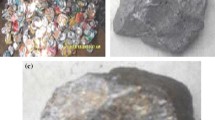Abstract
A finished two-piece drawn and ironed aluminum can is composed of a bottom, sidewall, neck, flange, and applied end. Each requires attention to detail and each has proponents for particular methods of manufacture. A recent program developed at Alcoa for lightweighting of cans in a cost-effective manner leads to the present research effort. This effort is aimed at increasing the fundamental understanding of end-coining processes and in developing a stronger and lighter can end.
This article provides a critical review of the current coining practices used for container end enclosures. A significant number of patents were studied, but only those that were relevant to this work are summarized in the present article. It was found that the classical definition of coining has been loosely used in the can industry and is misinterpreted at times. Therefore, a new terminology has been given to coining of ends, namely,end-coining. The termend-coining is used to describe any restriking operation which improves the strength or slightly modifies the geometry of the can end closures. The word “end” refers to a container (beer/beverage/food can) lid.
Similar content being viewed by others
References
Y. Bocharov, S. Kobayashi, and E.G. Thomsen; Trans. ASME, Series B,J. Eng. Ind., 1982, 84, vol. 84, p. 491.
E.G. Thomsen, C.T. Yand, and S. Kobayashi:Mechanics of Plastic Deformation in Metal Forming, Macmillan, New York, 1965.
J.M. Monaghan and A.A. Torrance:Met. Technol., 1984, vol. 11, p. 20.
J.M. Monaghan and M. O’Rielly:Int. J. Mach. Tool. Des. Res., 1986, vol. 26, p. 385.
J.M. Monaghan:J. Mech. Work. Technol., 1988, vol. 16, p. 175.
S. Tanaka and K. Sato: “Development of Metal Forming Simulation System Based on Rigid Plastic FEM. II—Solution of the Problem of Singularity in Finite Element Analysis of Free-Forging Process,”J. Jpn. Soc. Technol. Plast. 1985, vol. 25, No. 289, p. 190.
E.R. Speakman: “Stress Coining Procedures for Fatigue Improvement,” McDonnell Douglas Report MDC J 5588, 1972.
A. Phillips: “Improvement of Fatigue Life of Aircraft Components by Coining,” McDonnell Douglas Report DEV 3398, 1961.
A. Phillips: “Coining Structural Parts,” U.S. Patent No. 3,110,086 of December 11, 1963.
P.V. Kaskard, E.E. Day, and A.S. Kobayashi: “Exploratory Study on Optimum Coining for Improvement of Fatigue Life,”Experimental Mechanics, October, 1964, p. 297.
J.E. Moon: “Coining Die,” U.K. Patent No. 2,082,951 A of July 8, 1981.
Shao-Wen Yen: “Theory of Stress Coining Technique,”Eng. Fracture Mech., 1981, vol. 14, p. 477.
O.L. Brown and E.C. Fraze: “Easy-Open Tear Strip Reinforcing Means,” U.S. Patent No. 3,664,543 of May 23, 1972.
O.L. Brown and E.C. Fraze: “Can End With Inseparable Tear Strip,” U.S. Patent No. 3,870,001 of March 11, 1975.
O.L. Brown and E.C. Fraze: “Easy-Open Ecology End,” U.S. Patent No. 4,024,981 of May 24, 1977.
O.L. Brown, D.B. Peters, and J.R. Schubert: “Can End With Retained Tear Strip,” U.S. Patent No. 4,503,989 of March 12, 1985.
R.E. Heffner: “Easy-Opening Device for a Container End,” U.S. Patent No. 3,618,815 of November 9, 1971.
N.E. Langseder: “Tool for Coining,” U.S. Patent No. 4,424,698 of January 10, 1984.
H.A. Peyser and E.J. Herbst: “Coined End Panel,” U.S. Patent No. 3,912,113 of October 14, 1975.
C.L. Jordan: “Tabless Container Opening Device and Method and Tools for Forming the Same,” U.S. Patent No. 3,946,683 of March 30, 1976.
J.W. DeLine and N.N. Ida: “Container Lid and Method of Manufacturing,” U.S. Patent No. 3,949,692 of April 13, 1976.
A.P. Zundel: “Panel With Opening Means,” U.S. Patent No. 4,132,328 of January 2, 1979.
A.P. Zundel: “Method for Forming Opening Means in Panel,” U.S. Patent No. 4,149,479 of April 17, 1979.
G.B. Klein: “Push-Down Gate in a Raised Aperture in a Can End,” U.S. Patent No. 4,215,792 of August 5, 1980.
R.F. Madden and D.B. Moreau: “Easy-Opening Can End,” U.S. Patent No. 4,196,823 of April 8, 1980.
A.H. Boardman: “Can End Closure,” C. A. Patent No. 1,127,568 of July 13, 1982.
J.M. Schubert, O.L. Brown and E.C. Fraze: “Combined Can and End with Means for Protecting Against Severed Score,” U.S. Patent No. 3,765,352 of October 16, 1973.
T.M. Westphal: “Method and Apparatus for Forming a Non-sliver Scored Metal End,” U.S. Patent No. 4,354,784 of October 19, 1982.
O.L. Brown: “Easy Open Can End Resistant To Pressure,” U.S. Patent No. 3,900,128 of August 19, 1975.
T. A. Nguyen: “Buckle Resistance for Metal Container Closures,” U.S. Patent No. 4,434,641 of March 6, 1984.
T.A. Nguyen: “Buckle Resistance for Metal Container Closures,” U.S. Patent No. 4,577,774 of March 25, 1986.
R.E. Dick: Alcoa private communication, November 25, 1986.
Author information
Authors and Affiliations
Rights and permissions
About this article
Cite this article
Chu, E. A critical review of the current end-coining practices for container end closures. J. Materials Shaping Technology 7, 91–103 (1989). https://doi.org/10.1007/BF02833775
Issue Date:
DOI: https://doi.org/10.1007/BF02833775




